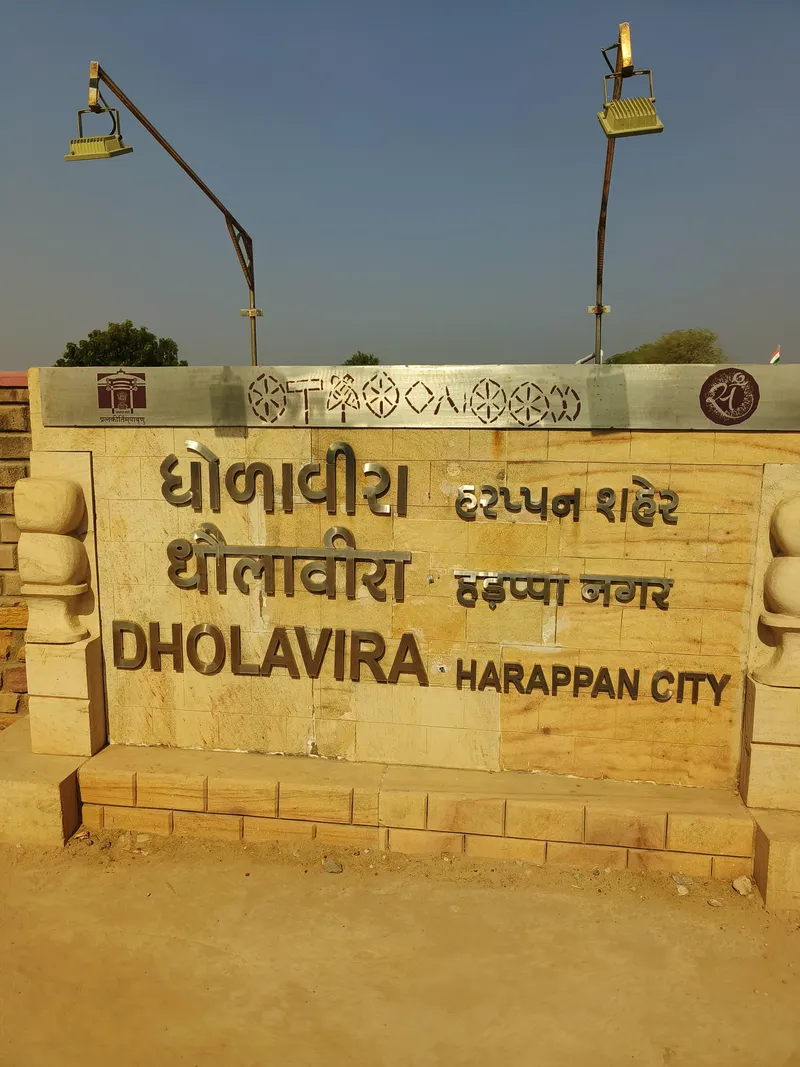Kutch beyond the salt marsh: Exploring the Harappan city of Dholavira
Exploring through time to unearth lessons that make Dholavira, an ancient township of the Harappan civilisation far ahead of its time in its architecture.
While the glistening white salt marshes of Kutch have attracted travellers from far and beyond, the region is home to many other sites that tell stories of yore. One such is Dholavira, once the southern centre of the Harappan civilisation on the arid island of Khadir Bet.
A UNESCO World Heritage Site, Dholavira is listed among the most well-preserved urban settlements that existed between 3000 BCE and 1500 BCE. And it’s not every day one gets to explore the ruins of a 5,000-year-old ancient city that holds within itself long-buried secrets.

The entrance to Dholavira
Our journey began from the Dhordo village (home to the annual Rann Utsav festival) to Dholavira via the Road to Heaven. True to its name, the 32-km road seemed unending, with Arabian Sea backwaters and salt marshes on either side. There were no security personnel to man this road, making it an obvious hotspot for Instagrammers to indulge in endless photo-ops.
An hour-long ride from here took us to Dholavira, which showed evidence of a well-planned city through its architecture, metallurgy, water management system, and more.
However, what was heartbreaking was the lack of upkeep. With no entry fee, one found all kinds of visitors, many hardly interested in history or archaeology, casually sitting on walls or touching remains without care.
A fascinating exploration
Stepping into Dholavira is like entering a time warp. Every corner of the Harappan city makes your imagination run wild, conjuring images of its homes and the people who lived in the city aeons ago.
Your curiosity will be put to rest in intervals, as the many signboards along your path reveal details (or visual evidence) that offer a peek into its original form.

The east reservoir in Dholavira
A conjectural view of the township is your first introduction to Dholavira. Another board in close proximity visually represents its magnet points, featuring an east-west arterial street, a baily, stairways, and tanks. The common thread? Each of these elements reflects architectural excellence in thought and execution.
As we scribbled notes and took photos, I remember our guide Iqbal (part of Evoke Experiences) told us more about the walled city. There was so much that existed—a fortification, entranceway, water reservoirs, ceremonial ground, residential units, workshop spaces, and a cemetery.
“If you look around, you will find a citadel for the higher-ups, a middle town for businessmen and traders, and a lower town. There was also a sports stadium and a series of water resources within the city,” he added.
Whether you are an archaeology geek or not, it won't take you too long to acknowledge the meticulous planning and farsightedness of the inhabitants. They managed to create a water management system that sustained the entire city. If numbers are to go by, there were over 16 reservoirs of varying sizes, making up almost 10 hectares of the entire area!
There were many more fascinating facets that intrigued us. For example, a signboard revealed that residents of Dholavira used shells to create bangles, beads, weights, inlay pieces, and decorative items, to name a few.
Also, the township was once home to a bead factory. Excavations also point to a weekly haat or bazaar that used to be held at the centre of the middle town, which was also the site for a sports stadium where bull or horse fights were held.
Is there more?
This is only scratching the surface of Dholavira’s wealth of history because there's so much to learn. While most people end up going for a day trip, you could stay back and spend more time here. There's also a museum in Dholavira, offering insights into the civilisation that was (unfortunately, there's no museum guide to take you around here).

A museum within Dholavira displays daily objects and artefacts discovered during the excavations
Where to stay: One of the most luxurious and comfortable accommodations is Evoke Dholavira, with 44 well-appointed cottages that offer a blend of aesthetics and heritage. Each of the rooms is adorned with images of the ancient site of Dholavira, transporting visitors to a different era.
The resort also has a swimming pool, clubhouse, outdoor games, and a fine dining restaurant providing local meals.
Edited by Kanishk Singh







